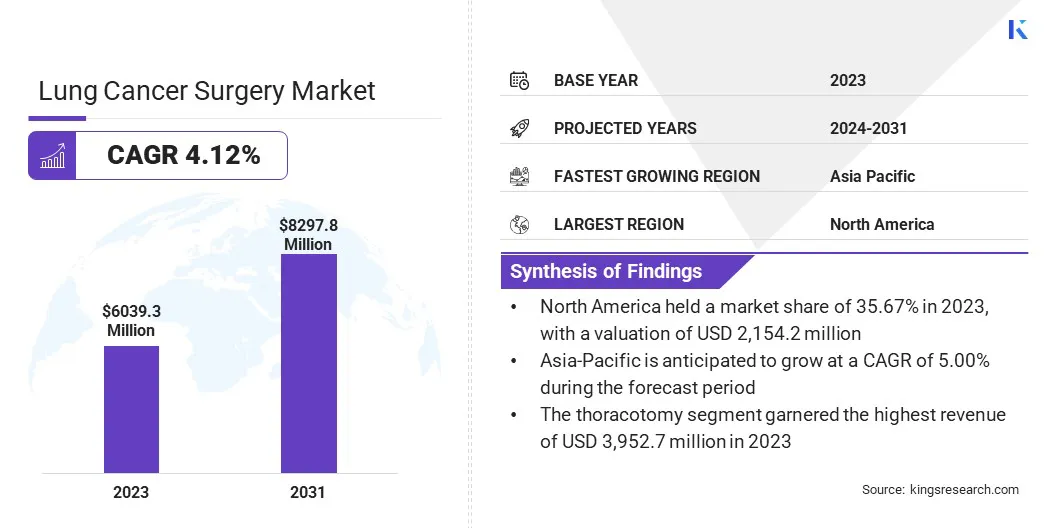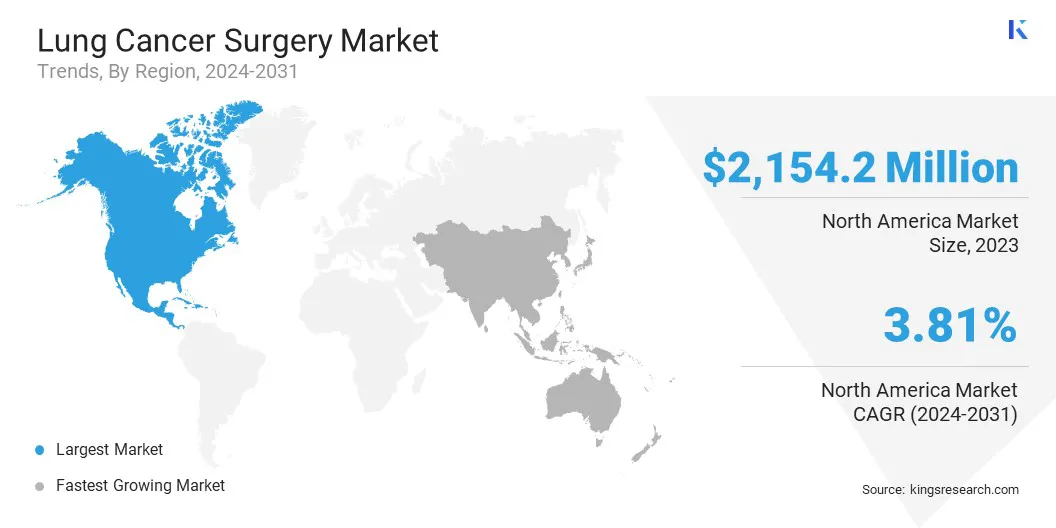Lung Cancer Surgery Market Size
The global Lung Cancer Surgery Market size was valued at USD 6,039.3 million in 2023 and is projected to grow from USD 6,255.9 million in 2024 to USD 8,297.8 million by 2031, exhibiting a CAGR of 4.12% during the forecast period. In the scope of work, the report includes solutions offered by companies such as Accuray Incorporated, AngioDynamics, Intuitive Surgical, Olympus America, Teleflex Incorporated, Karl Storz SE & Co, Siemens Healthcare Private Limited, Medtronic, Wexler Surgical, Richard Wolf GmbH and others.
The lung cancer surgery market is experiencing significant growth, driven by rising incidence rates, technological advancements, and increasing investments in healthcare infrastructure. Lung cancer remains a major health concern, with a high mortality rate due to late-stage diagnosis and the aggressive nature of the disease. This has spurred the demand for more effective diagnostic and treatment options, thereby propelling market growth.
The growing prevalence of lung cancer, particularly due to high smoking rates, environmental pollution, and aging populations, is boosting the expansion of the market. Early detection and timely intervention are crucial, leading to increased demand for advanced diagnostic tools and treatment options.
Innovations in diagnostic technologies, such as low-dose computed tomography for early detection, liquid biopsies, and advanced molecular diagnostics, are significantly enhancing early detection capabilities, thus augmenting market growth. The development of targeted therapies and immunotherapies is revolutionizing lung cancer surgery care by offering more personalized and effective treatment options.
- For instance, according to data published by the American Cancer Society (ACS) in 2022, lung cancer, including both small cell and non-small cell types, ranks as the second most prevalent cancer in both men and women, accounting for nearly 25% of all cancer-related deaths.
Lung cancer surgery refers to the surgical procedures performed to treat lung cancer by removing cancerous tumors or affected lung tissue. It is a crucial component of treatment for patients diagnosed with lung cancer, aiming to eliminate or reduce the spread of cancer cells in the lungs. The types of surgery vary depending on factors such as the size and location of the tumor, the overall health of the patient, and the stage of the cancer.
Common surgical approaches include lobectomy, segmentectomy (removal of a segment of the lung), and wedge resection (removal of a small section of lung tissue). Advanced techniques such as minimally invasive surgery and robotic-assisted surgery are increasingly utilized to enhance surgical precision and reduce recovery times for patients.

Analyst’s Review
A significant factor supporting the progress of the market is the integration of advanced diagnostic tools and technologies.
- For instance, the development of AI-driven tools such as Sybil, which accurately predicts lung cancer risk with high precision (NBC UNIVERSAL, April 12, 2023), enhances early detection capabilities,. This enhancement is crucial for improving patient outcomes through earlier intervention and treatment.
Furthermore, Key market players are strategically advancing through partnerships and technological innovation.
- For instance, VOCxi Health's collaboration with Silicon & Software Systems Ltd., announced on August 23, 2023, aims to pioneer new lung cancer detection and monitoring devices, with a focus on enhancing diagnostic accuracy and clinical application. Moreover, initiatives such as the NHS's "Help Us Help You" campaign, launched in August 2022, educate at-risk populations about the importance of early detection, which is crucial for effective treatment.
These efforts complement ongoing advancements in AI, robotics, and minimally invasive techniques, bolstering both surgical precision and recovery outcomes.
Lung Cancer Surgery Market Growth Factors
The increasing prevalence of lung cancer surgery globally is a primary factor aiding the growth of the lung cancer surgery market. Factors contributing to this rise include higher smoking rates, especially in emerging economies, and exposure to environmental pollutants and carcinogens.
Additionally, an aging population, which is more susceptible to lung cancer surgery, further exacerbates the incidence rates. The growing number of cases highlights the pressing need for advancements in diagnostic tools, treatment options, and supportive care, thereby augmenting market growth.
- Lung cancer is the leading cause of cancer-related deaths worldwide, accounting for the highest mortality rates among both men and women. According to the World Health Organization (WHO), smoking is the major cause of lung cancer, responsible for approximately 85% of all cases.
The high cost of treatment is hindering market growth in the lung cancer surgery sector, particularly impacting patient access to advanced surgical techniques and innovative therapies such as immunotherapy. These expenses pose significant barriers in regions with limited healthcare resources and inadequate insurance coverage. To address this challenge, key players are actively implementing several strategic initiatives.
They are forming partnerships with healthcare providers, insurers, and governmental agencies to develop cost-effective solutions such as bundled payment models and value-based care programs. Significant investments in research and development aim to enhance surgical technologies and treatment efficiency, thereby reducing costs.
Furthermore, numerous companies are implementing patient assistance programs to alleviate financial burdens for patients, by offering subsidies, grants, and flexible payment options to enhance treatment accessibility, which is slated to spur market growth.
Lung Cancer Surgery Market Trends
The growing shift toward personalized medicine is a notable trend in the market, significantly propelling its growth. Personalized medicine involves tailoring treatment plans to individual patients based on genetic, biomarker, phenotypic, or psychosocial characteristics. Advances in genomics and molecular biology have enabled the development of targeted therapies that specifically attack cancer cells with certain genetic mutations, such as EGFR, ALK, and ROS1.
This approach is leading to more effective treatments with fewer side effects compared to traditional chemotherapy. Due to this, patient outcomes are improving, which in turn is increasing the demand for molecular diagnostics and targeted therapies. This trend is boosting the growth of the lung cancer surgery market by necessitating precision surgical interventions that align with the specific genetic profiles of patients' tumors, thereby enhancing the overall effectiveness and success rates of surgical treatments.
Immunotherapy is rapidly gaining traction as a transformative approach to lung cancer treatment, significantly impacting the market. Therapies such as immune checkpoint inhibitors (e.g., pembrolizumab, nivolumab) have shown significant efficacy in treating certain types of lung cancer by enhancing the body’s immune response against cancer cells. The success of these treatments in clinical trials and their subsequent approval by regulatory bodies are fostering further research and development in this area.
In addition, the market is witnessing an expansion in the use of immunotherapies, both as standalone treatments and in combination with other modalities like chemotherapy and targeted therapies. This integration of immunotherapy into surgical treatment plans is enhancing surgical outcomes, reducing recurrence rates, and improving overall patient survival, thereby contributing to market growth.
Segmentation Analysis
The global market is segmented based on surgical procedure, surgical devices, and geography.
By Surgical Procedure
Based on surgical procedure, the lung cancer surgery market is categorized thoracotomy and minimally invasive surgeries. The thoracotomy segment garnered the highest revenue of USD 3,952.7 million in 2023 as a result of its essential role in treating complex and advanced-stage lung cancers. Despite the rise of minimally invasive techniques, thoracotomy remains crucial for accessing and treating larger tumors effectively.
Its continued demand is facilitated by the imperative to address diverse patient needs, especially in cases where more extensive surgical interventions are required. Advances in perioperative care and surgical techniques within the thoracotomy procedure contribute to improved patient outcomes, thereby fostering confidence among both healthcare providers and patients, which is expected to stimulate market growth.
By Surgical Devices
Based on surgical devices, the market is divided into surgical instruments, monitoring devices & systems, and endosurgical equipment. The surgical instruments segment captured the largest lung cancer surgery market share of 54.34% in 2023.
These instruments encompass a range of tools used in various surgical procedures, including thoracotomy, VATS (Video-Assisted Thoracoscopic Surgery), and robotic-assisted surgeries. The segmental growth is proeplled by ongoing technological advancements that enhance precision, reduce surgical times, and minimize post-operative complications.
Innovations such as minimally invasive instruments and robotic systems improve surgical outcomes and patient recovery, thereby increasing their adoption. Moreover, the growing volume of lung cancer surgeries worldwide contributes to the continuous demand for advanced surgical instruments, further boosting segmental expansion.
Lung Cancer Surgery Market Regional Analysis
Based on region, the global market is classified into North America, Europe, Asia-Pacific, MEA, and Latin America.

The North America lung cancer surgery market share stood around 35.67% in 2023 in the global market, with a valuation of USD 2,154.2 million. The region boasts a high prevalence of lung cancer and advanced healthcare infrastructure, particularly in the United States, supported by substantial healthcare spending and comprehensive insurance coverage. The rapid adoption of cutting-edge diagnostic and therapeutic technologies, including molecular targeted therapies and immunotherapies, aids market expansion.
Robust research and development activities, bolstered by stringent regulatory frameworks and the presence of leading pharmaceutical firms, continually advance treatment options. Increased awareness regarding lung cancer symptoms and the importance of early detection further enhances patient outcomes, fostering the growth of the North America market.
Asia-Pacific is anticipated to witness the highest growth, registering a CAGR of 5.00% over the forecast period, largely due to increasing incidence rates and improving healthcare infrastructure. Countries such as China, Japan, and India are key contributors to this growth, mainly attributed to various factors such as rising pollution levels, high smoking rates, and an aging population.
The region is witnessing substantial investments in healthcare, leading to better access to diagnostic and treatment facilities. Governments are implementing policies to enhance cancer care and increase public awareness regarding lung cancer surgery. Additionally, the growth of the pharmaceutical industry in this region, coupled with the availability of affordable generic drugs, is making lung cancer surgery treatments more accessible.
The widespread adoption of advanced technologies, including molecular diagnostics and immunotherapies, is gradually increasing, supported by ongoing research and development activities. Efforts to improve early diagnosis and personalized treatment approaches are increasingly gaining traction, augmenting the Asia-Pacific lung cancer surgery market expansion.
Competitive Landscape
The lung cancer surgery market report will provide valuable insight with an emphasis on the fragmented nature of the industry. Prominent players are focusing on several key business strategies such as partnerships, mergers and acquisitions, product innovations, and joint ventures to expand their product portfolio and increase their market shares across different regions.
Companies are implementing impactful strategic initiatives, such as expanding services, investing in research and development (R&D), establishing new service delivery centers, and optimizing their service delivery processes, which are likely to create new opportunities for market growth.
List of Key Companies in Lung Cancer Surgery Market
- Accuray Incorporated
- AngioDynamics
- Intuitive Surgical
- Olympus America
- Teleflex Incorporated
- Karl Storz SE & Co
- Siemens Healthcare Private Limited
- Medtronic
- Wexler Surgical
- Richard Wolf GmbH
Key Industry Development
- March 2023 (Partnership): AstraZeneca (Thailand) Company Limited signed a Memorandum of Understanding (MoU) with Phyathai 2 Hospital to implement AI-based technology for chest X-rays. As part of the "Advancing Early Lung Cancer Screening with AI Technology" campaign, this initiative aimed to enhance the efficiency of early-stage lung cancer screening. The partnership also sought to raise awareness regarding the importance of regular health check-ups and lung cancer screening, aiming to improve the quality of life of individuals.
The global lung cancer surgery market is segmented as:
By Surgical Procedure
- Thoracotomy
- Minimally Invasive Surgeries
By Surgical Devices
- Surgical Instruments
- Monitoring Devices & Systems
- Endosurgical Equipment
By Region
- North America
- Europe
- France
- U.K.
- Spain
- Germany
- Italy
- Russia
- Rest of Europe
- Asia-Pacific
- China
- Japan
- India
- South Korea
- Rest of Asia-Pacific
- Middle East & Africa
- GCC
- North Africa
- South Africa
- Rest of Middle East & Africa
- Latin America
- Brazil
- Argentina
- Rest of Latin America


